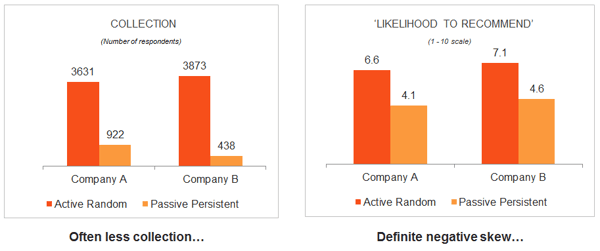Firstly, let’s start with random active solicitation which collects feedback by inviting a random portion of your website visitors on arrival to the website to take a survey at the end of their visit. This provides a representative sample which creates internal alignment and helps drive strategic decisions.
Passive Persistent Approach
Alternatively, a passive persistent approach collects individual feedback where visitors can click a button to leave their feedback, and is commonly referred to as a Comment Card. iPerceptions research shows that visitors who leave feedback using a passive persistent approach are more likely to leave negative feedback.
The graphs below demonstrate this negative skew of results and relatively low participation rates using passive persistent engagement compared to active random solicitation.

Therefore, passive persistent approaches are more of a remediation tool that can help fix broken links and give visitors an outlet to vent.
Targeted engagement
The final engagement method is targeted engagement which collects feedback by showing a survey invite to a specific audience based on behavioral criteria such as number of pages viewed or time on site. It is typically used to optimize sections of a website or a particular site feature. As an example, by triggering a survey to collect feedback from visitors who visited only the support section of your site, you can understand how effectively your online support tools are meeting visitors’ needs and how you can optimize those resources.
It is important to understand that not all engagement methods are equal. The method or methods you choose to adopt as part of your customer experience program will ultimately impact the type of data you collect (Representative to individual) and how it can be used (Strategic to tactical).
2. The most reliable feedback comes from the moment of truth
Recently, I visited my bank’s website and a few days later I received an email asking for feedback about my experience. As you can imagine, my ability to remember the experience was not adequate to answer many of the questions within the survey. Questions such as how the website’s navigation and content affected my ability to accomplish my tasks, were especially difficult to answer this long after the fact.
This is an example of why it is essential to engage and collect feedback about the customer experience in the moment of truth i.e. At the most critical time in their browsing/shopping experience.
If the bank had engaged me, the visitor, immediately following my experience, they would have captured insights that more accurately defined my true experience and intentions.
Therefore, it is essential that your CX program does not simply include customer feedback, but feedback captured in the moment of truth.
3. The respondent experience matters
Asking your visitors for feedback is an extension of your brand. This means it is essential to customize your research to match your brand; from survey invitation to thank you page, ensure your company is front and center.
Typically, customers are more willing to open up to people that they know and trust. Also, this can help ensure your potential respondents know that this study is being conducted by you, and that their responses are being sent directly to your company for your review.
Another aspect to the respondent experience is to be honest and transparent and never interrupt. That’s why you should provide customers with a clear and easy way to opt out, and when they don’t want to provide feedback you don’t immediately ask them again. Therefore, whether customers participate or not, this approach builds integrity for the brand and tells all your customers that their opinion matters, whether or not they have the time to provide it.
As you start to lay the ground work for building your customer experience program, ensure it is not detached from your website but an extension of your brand that engages your customers in an honest and transparent way.
The customer experience is mission critical today and can’t be ignored. As you start to make the first steps towards creating a customer experience program remember that not all engagement methods are created equal, capturing feedback in the moment of truth will be critical and don’t ignore the respondent experience.




Inherent in the “three things”, especially in the second one, is some understanding of what goal emotions and memories are desired. One of the key reasons so many customer experience, engagement, and loyalty programs miss the mark is that they are commoditized and generic. If there is no mechanism for identifying what elements of the experience create, and don’t create, desired memory, even immediacy of follow-up is unlikely to offer much insight. This can be determined through targeted emotional response and memory research, beta-testing, or A/B testing
Hi Duff
The fact that your ‘ability to remember (an individual touchpoint during) the experience was not adequate to answer many of the questions within the survey’ rather suggests that the performance during individual touchpoints would be unlikely to affect your attitude towards the company afterwards.
As the research in behavioural psychology suggests, it is post-experience attitude that largely drives future repurchase intentions. For example, Verhoef et al in ‘Service Processes as a Sequence of Events: An Application to Service Calls’ found that customers assess experiences as a sequence of touchpoints (rather than individual ones), and that the usefulness, the peak and the end of the experience were critical in their assessment.
Why irritate customers by continuously asking for their feedback, touchpoint-by-touchpoint, when we know it doesn’t have a big impact on customer behaviour.
Graham Hill
@grahamhill